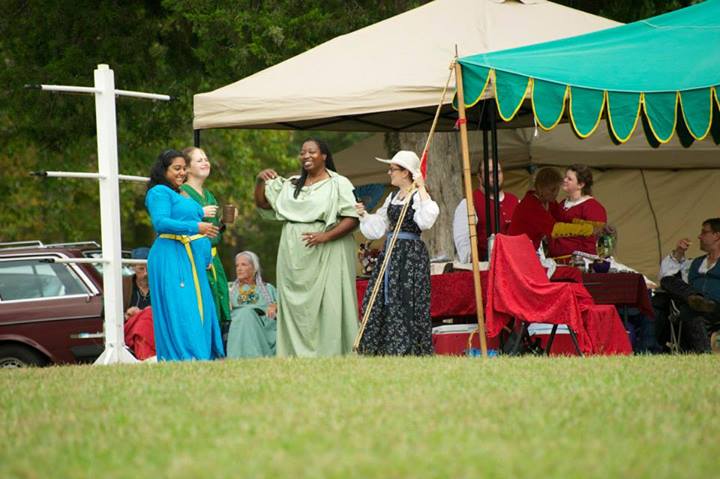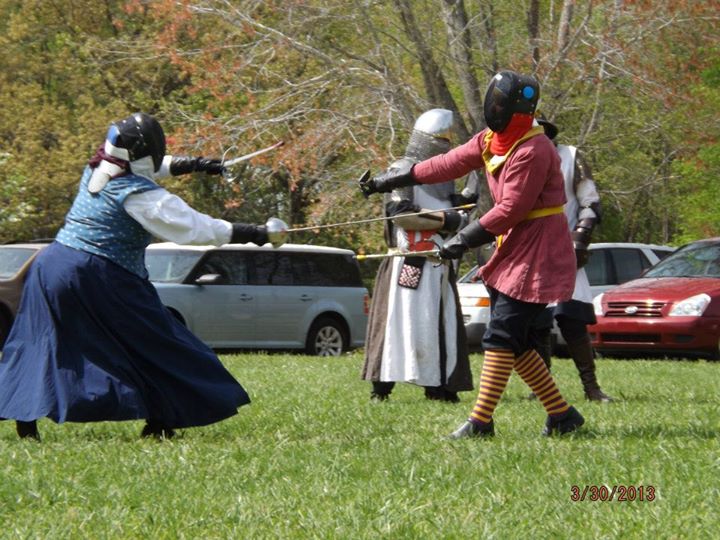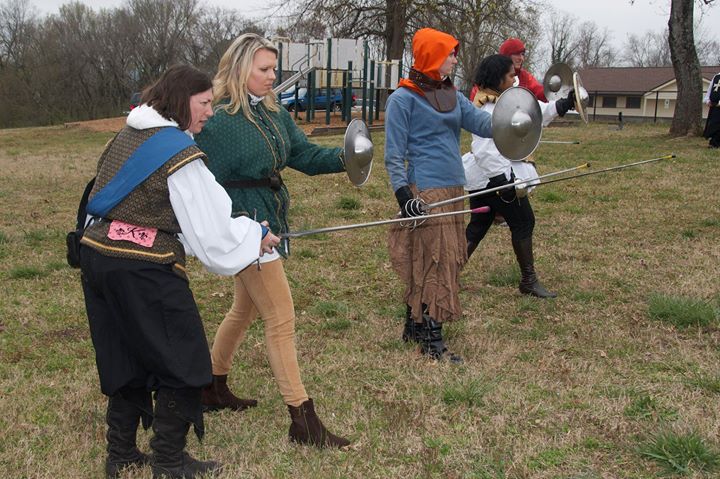Original post: 14 Feb 2014
The views expressed herein are those of the author and not necessarily the views of Esfinges.
By Nazirah Jetha Garrison
“What is the SCA?”, those of you in the HEMA community might ask, “Do they make it all up or do they actually study the sources?”, “Why do they dress up?”. Here I would like to give an insight into just how historical the SCA can be. Far from being a game of dress-up or plain reenactment, we take our research seriously and apply the treatises in our swordplay.
Well, first and foremost, the SCA is a not-for-profit educational organization. The very core of its being is education of its members, and education of its non-members if they ask. We make things, we research things, and the things we make, we try to research how it would have been done in its time period, and try to recreate that. We do demos at libraries, parks, private events, churches. We’re not “reneactors” though, more sort of re-creationists of the middle ages, but with modern medicine and plumbing. 😉

HEMA, in particular, rapier fighting, has been a part of the SCA since the late 1970s/early 1980s. I’ll be honest: back in the 80s, there was a lot of what is now termed “basic SCA style fencing”; it didn’t pay heed to the sources, and boiled down to winning at all costs. Form and style didn’t matter; only winning and fighting like the actors they saw in movies. But, a large number of us decided to apply the same “research, recreate, and make as accurate as possible” principles that others in the SCA had to food, or to costuming, to HEMA. In particular, to rapier fighting.
To start with, let’s consider a typical rapier practice. We’ll take it as given that the preliminaries have been done. First, we warm up; some lunges, some sword drills, either stabbing at a pell, or going through some basic sword “katas”, more chitchat while we warm up, etc etc. Then, we might engage in some free sparring with weapon combinations of our choice. This Sunday, it was sword and dagger. So, I went out into the fighting space, and faced my opponent. Found his weakness and stabbed him. And again. Possibly even a third time. At this point, our teacher called “hold” (basically, “stop!! I’m coming over!”), went over to my opponent and told me to come back into my guard. I did so.
What happened next was essentially a full on discussion regarding the geometry of lines and planes applied to a woman holding a rapier in one hand and a dagger in the other, both pointed straight at you. He talked about how the medieval masters would suggest that my opponent try to find the weak line. That as my stance was a rather aggressive stance, straight out of Giganti or Capo Ferro, with head back, rapier held on point, but not extended, and dagger forward, that my opponent could not gain mechanical advantage over my rapier; in Giganti’s terms, he couldn’t gain my blade. My teacher then went on to ask how could my opponent gain an advantage over me? This ended up in a discussion of how Capo Ferro and Giganti defined tempo, measure and gaining the blade. How, both authors said that to win, one had to control at least one of the three, and what my opponent could do when faced with me in this stance. We then sparred, putting these principles into practice.
Then we had a water break, and I picked up my copy of Venetian Rapier that I’ve been working through. I was having an issue with one of the early plates regarding the timing and and ultimate hand positioning of the cavazionne, and how to attack using the tempo given to you when your opponent did a cavazionne based on your control of his blade. The teacher and I discussed it, and he set me in the right direction. This led to a discussion of blade mechanics, parity of the blade, mechanical leverage, and Giganti’s use of feints.
Fully rested and watered, we picked back up, but with sword and buckler this time, and a discussion of Bolognese sword and buckler techniques; how the various guards illustrated in the manuals worked, and what they were good for. Then we sparred, using those techniques.

When I get out onto the field, I’m not thinking about overwhelming my opponent with brute force, I’m thinking about his/her guard, where the weak spots are, how I can exploit what my opponent’s given me. I think this scenario, which happens on a nigh-weekly basis, sums it up — my other teacher, Kristyn, and I face off regularly against each other. Given that we’re both short-ish women, with very similar personalities, we’d both take similar guards, and we generally stand there for a while, in guard, facing each other, figuring out what to do. Well, I figure out what to do, I think Kristyn stands there and waits for me to make a mistake she can exploit! This tends to be the conversation on the sidelines:
“Um… What are they doing??”
“Fighting.”
“But… They’re not *doing* anything? Just twitching every now and then, and sometimes one of them moves their head or adjusts footing???”
“Wait for it….”
By this point we’ve generally sized each other up, and what follows is a usually a set of techniques from Capo ferro or Giganti, and results in one of us stabbing the other in the head. Or, binding each other up and having to resort to grappling (at which point we both back off).
Other weeks, the guided discussion and practice may focus around a plate out of Capo Ferro or Giganti, or Fabris (right now, we’re working our way through Capo Ferro with some Giganti thrown in for good measure), but no matter what, practice happens with the medieval/renaissance masters and their salles providing the backdrop.

That’s how we practice HEMA in the SCA, as a scholarly art, based off the historical manuals. We do also endeavor to put HEMA into its cultural context, which is where the clothing comes in. I mean, no one disses a kendo practitioner for wearing what they wear, right? Even if it is based on what they wore in Japan in the late Edo-period. Yes, we fight with a sword and cloak, or a cloak and dagger (there are sections in the historical manuals devoted to it, so why wouldn’t we?) and the clothing comes into the fight. If I fight in a skirt, an opponent can’t see my footwork and has trouble figuring out whether I’m refused or on guard. If my opponent’s blade gets caught in a fold of cloth, I can use that tempo to gain an advantage; just as would have happened historically. In some respects, the clothes help put HEMA into a wider context and culture and enable a fuller study. On the flip side, in the SCA we operate under stringent safety guidelines which means we can’t put all aspects of HEMA into practice; I’m not saying that either way is better, just that it offers a complementary view, and we have a heck of a lot to learn from each other.
Original Post: http://esfinges1.wix.com/e/apps/blog/historical-european-martial-arts-in-the-sca
